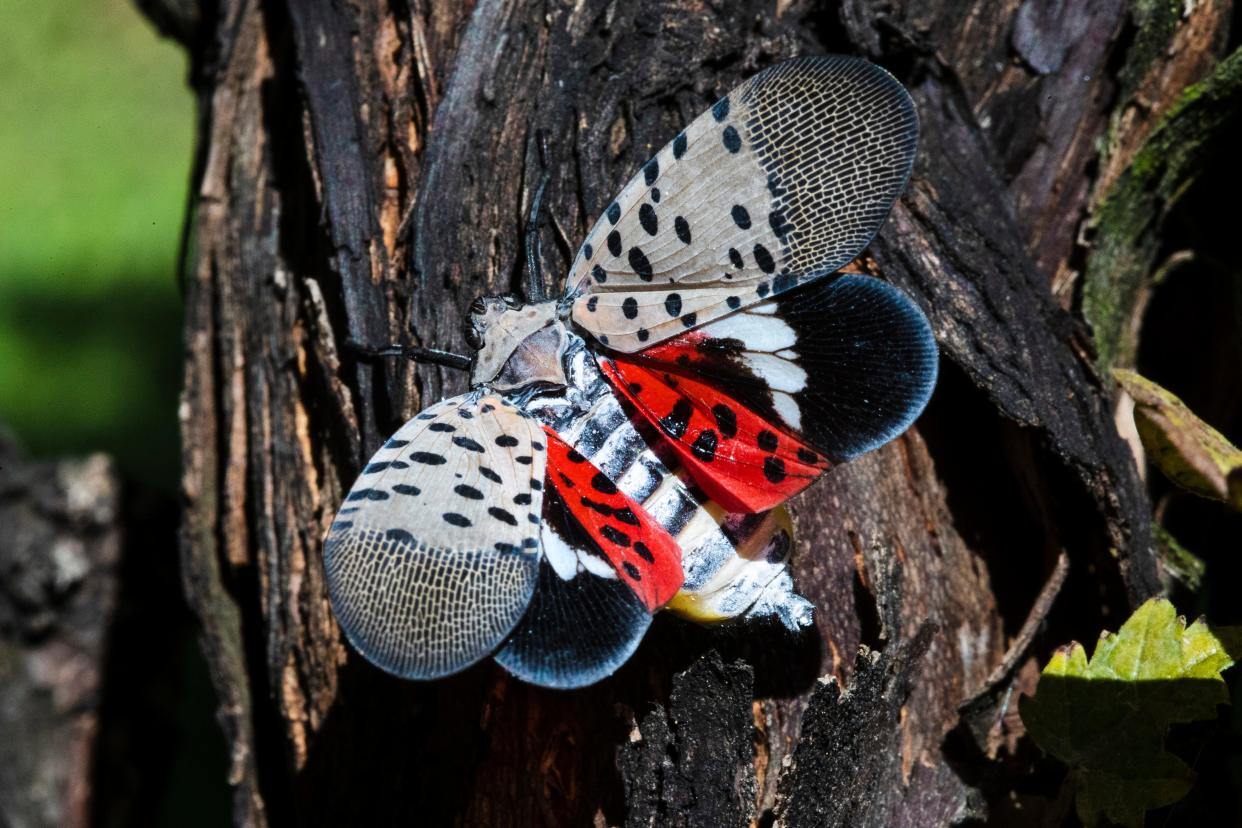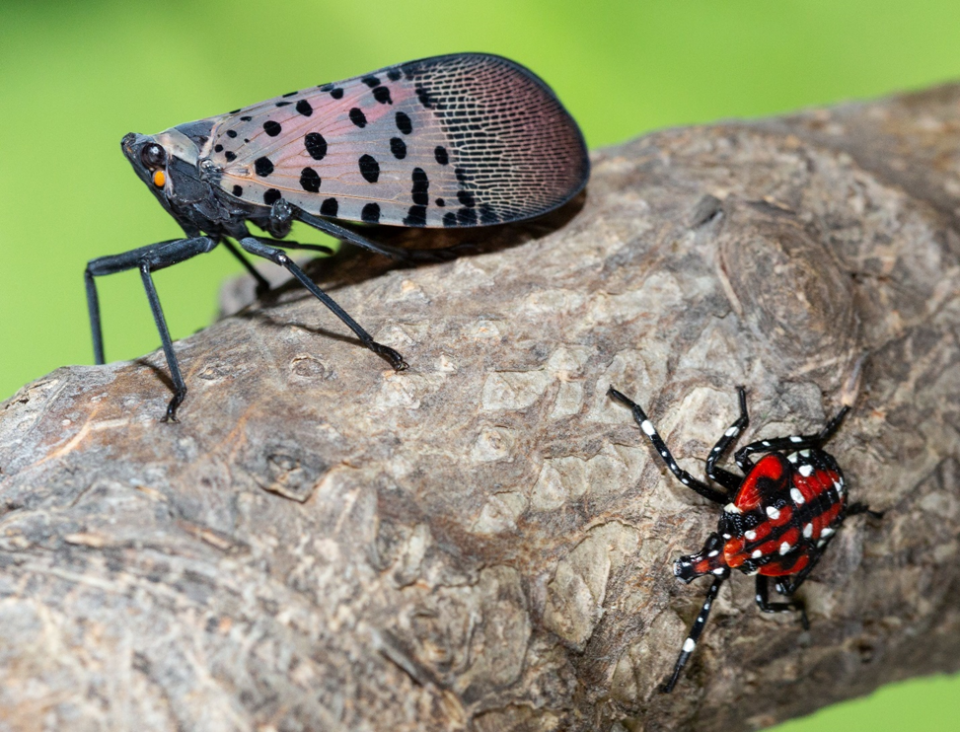Spotted lanternflies found in a second Indiana location. They're not welcome.

Kill them without mercy. That's the message being sent along the eastern seaboard of the U.S. and into the Midwest about an inch-long winged insect known as the spotted lanternfly.
It's also the message Megan Abraham, director of the state Division of Entomology and Plant Pathology, has for Hoosiers after the spotted lanternfly was discovered in the Huntington area in northern Indiana. The insect was first found in July 2021 in Vevay in southern Indiana.
The insect is a huge problem for wineries and orchards because it sucks the sap from vines and trees, slowing the growth of the fruit. For wineries, that changes the acidity of the grapes' juice, affecting the vintages created. Since the insect is from Asia, it has no natural predators and has been able to reproduce in large numbers.
First discovery in Indiana:Asian insect known to kill native plants, trees found in Indiana
Abraham and other state workers have been looking for the lanternfly in downtown Huntington, where it was discovered in July near a railroad track and a transportation company. Both railroad cars and semi-trailer trucks are known to spread the invasive insect from it was initially discovered in 2014 in Pennsylvania.
"We're not sure how it got there," Abraham said of the downtown Huntington location, "but it seems to point to one of those (railroad cars or semi-trailers) as being a contributor."
Now she and her staff are working to determine how big the infestation is while also trying to eradicate the insects. They were first found in southern Indiana last year in Vevay. The goal is to treat both locations before winter, when the adult insects will disappear.
Another invasive species that's spread throughout Indiana is contributing to the expansion of the spotted lanternfly. Tree of heaven (Ailanthus altissima) is an Asian species that's been spreading across the U.S. and is a favorite food source for the insect. The trees are often found in areas where the ground has been disturbed, such as along railroad tracks. The lanternflies climb high up on a tree, railroad car or truck trailer and then glide down to eat and reproduce. Because of that, Abraham and her staff are spraying trees with insecticide to kill any lanternflies.
"The truth is we have to do what we can to eradicate these new invasives as much as we can," Abraham said.
Why is the spotted lanternfly a problem?
The spotted lanternfly is a voracious eater that makes a mess, she explained. While people may not see the actual insect, if there are spotted lanternflies eating in trees or vines above, there will be sticky honeydew, or liquid insect excrement, underneath. If there is honeydew present, then blackish, sooty mold will soon follow. Sooty mold is a fungal disease that grows on surfaces where honeydew has been deposited.
"There can be so many of these insects it can almost be like it's raining," Abraham said.
While spotted lanternflies are a menace, they cannot harm people. Spotted lanternflies are a leafhopper and have mouthparts made for sucking the juice and sap out of plants, not biting.
Spotted lanternfly discovered at Butlery Winery in recent years
Besides tree of heaven, grapevines are another favorite snack for the insects, which is why Jim Butler, owner of Butler Winery in Bloomington, has been following the locations where spotted lanternflies have been discovered for the past three or four years.
"It looked like it came across on the Pennsylvania turnpike," Butler said, adding Purdue University and other agricultural officials have been discussing the insect in Indiana for some time. It's the same with winery officials: "Every meeting this past year, it's about the spotted lanternfly."
Butler said he's heard over and over again, "If you see it, step on it."
For Butler, it's just the latest in a long line of invasive pests causing problems. The first he can remember was the Japanese beetle, which was a huge problem in 1992 when the first grapevines were planted at Butler Winery. For the first year or two, workers picked off the beetles by hand. But then they were so thick that wasn't possible.
Others are reading:Timber rattlesnakes in Deam Wilderness captured on video in hypnotic dance for dominance
After a couple more years, the beetles weren't such a problem at the vineyard. Butler suspects it's because they spread out and predators started to eat them. He suspects the same eventually will happen with the spotted lanternfly.
"Sometimes these things show up and wreak havoc for five years or so and then it slows down," he said.
This year Butler said it's the birds not bugs that are the biggest problem. Netting over the grapes is the only way to prevent large losses of fruit. This year orchard orioles are the main trouble, along with robins and crows, he said. He doesn't expect the spotted lanternfly to be a problem this year.
"Maybe next year. Hopefully in five years," he said.

What to do if you see a spotted lanternfly
As with other invasive pest species, there are currently no natural predators to help keep spotted lanternfly populations in check.
"(Spotted lanternflies) are not really a known food source, which means it's a bit of a freefall in the beginning," Abraham said. "There's nothing out there to stop them except human beings."
That's why social media posts about the invasive insect are encouraging people to immediately kill any of the insects they see. Since it's early in the infestation in Indiana, Abraham said there isn't much research into what steps should be taken to stop the spread.
"We need to give the researchers and scientists who can help with this a little more time, especially before it hits the western states where there are more wineries," Abraham said.
She encourages anyone who thinks they may have seen a spotted lanternfly to call or email her department. Anyone who wants to share what they've seen or ask questions can call 1-866-NO EXOTIC (1-866-663-9684) or email depp@dnr.in.gov. People should leave their name, contact number and detailed information about what they are reporting. People are encouraged to share any photos they have taken.
For more on spotted lanternflies, go online to https://bit.ly/3TeCFus or https://bit.ly/3AKaFrf.
This article originally appeared on The Herald-Times: Spotted lanternfly in Indiana: Kill them, environmental experts say

